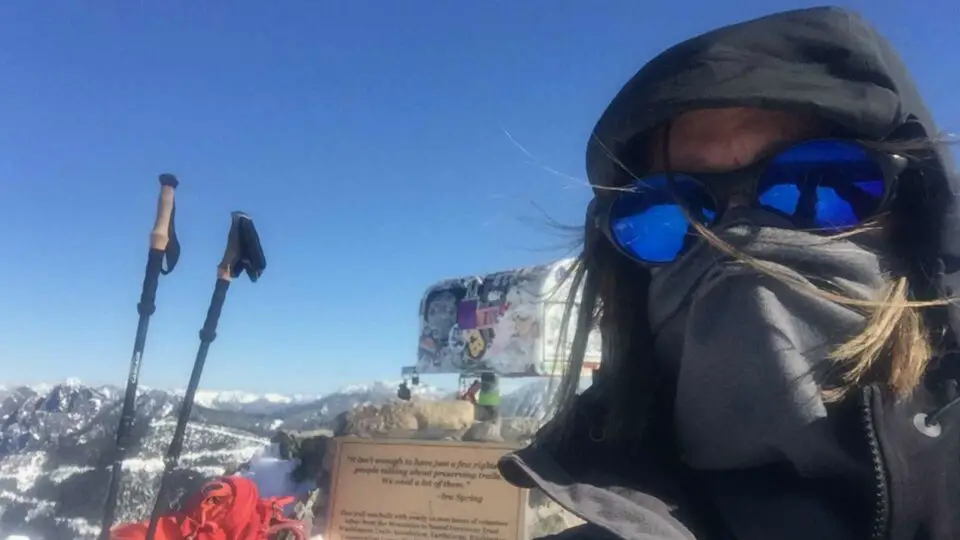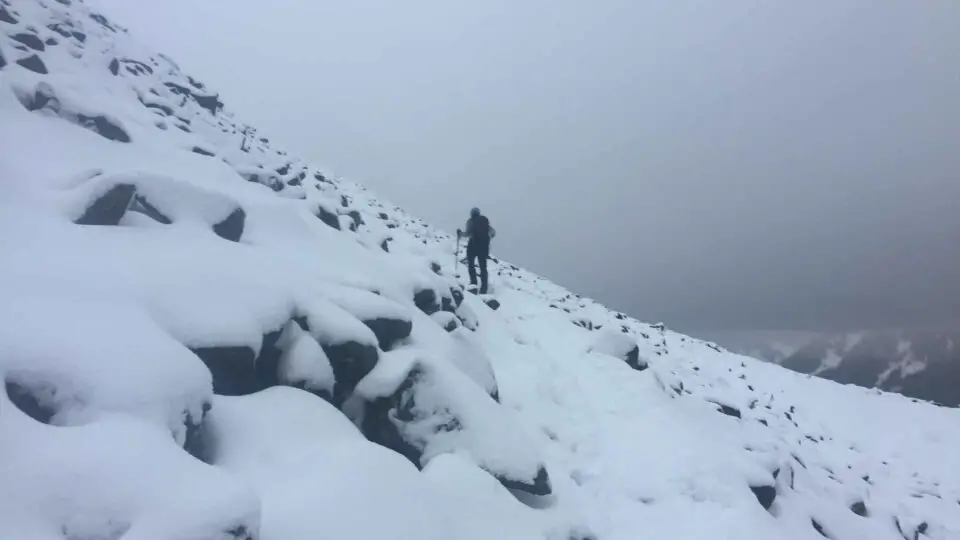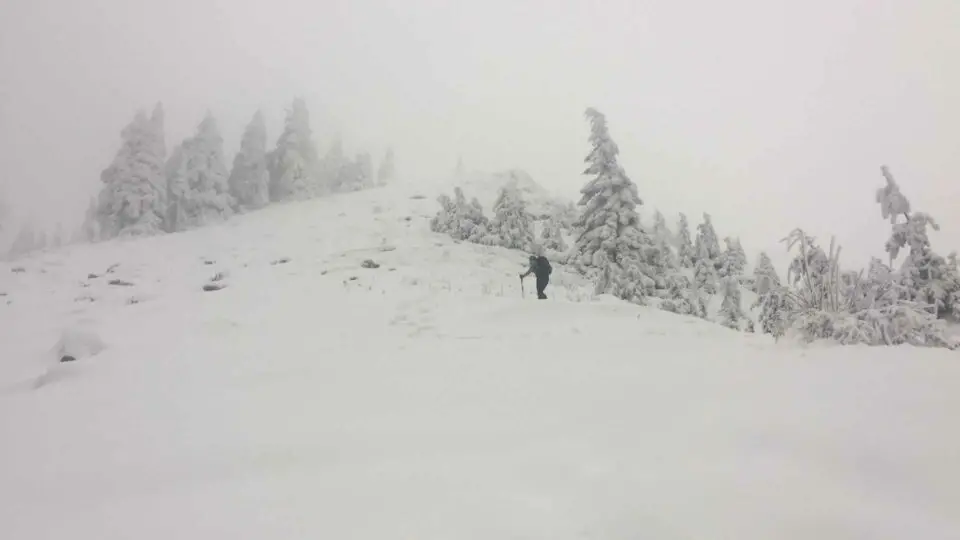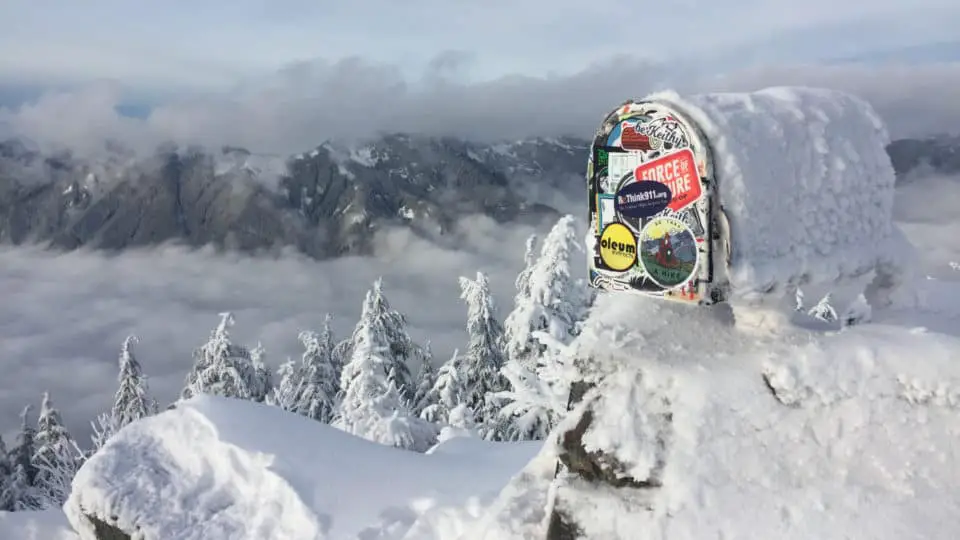With low avalanche danger, enough foot traffic to pack down an obvious trail, easy access via a paved road not far out of town, and parking near sea level, Mailbox Peak has quickly become one of western Washington’s favorite winter hikes.
There’s a segment of the hiking population that will generally stay away from snow, or will stick to lower, flatter hikes, often exploring the coastal region or urban trails during the winter, then resume mountain trails once they are melted out. But a lot of folks hike year round no matter what, enjoying a mix of snowy peaks and lowland hikes depending on weather and safety conditions. In the greater Seattle area, there are some common popular summer trails that become unsafe in the winter due to avalanche risk (Granite Mountain, Snow Lake, Lake 22) or inaccessible due to road issues (Colchuck Lake, Pilchuck Mountain, Mount Daniel), leaving a handful of options open to the hiker that enjoys a winter wonderland adventure. Mailbox is one of those, but there are some things to know before you go!
What Should I Wear?

Washington winters may be mild compared to other parts of the country, but at close to 5000 feet, it’s best to be over-prepared with layers. You can always take them off or leave them in your pack, but it sucks to have to turn around just because you aren’t prepared.
A rough formula to use to estimate summit temps is that you lose about 5º for every thousand feet of elevation, so if it’s 35º in the nearby town North Bend, the top of Mailbox will be close to 15º. Throw in some 20mph winds and you can see how a cute snowy walk at the base of the mountain quickly becomes an alpine mountaineering experience. I typically have on some or all of the following:
- Waterproof hiking boots
- Knee-high wool socks
- Gaiters
- Base layer wool bottoms
- Hardshell pants
- Wool sports bra
- Long-sleeved wool top
- Long-sleeved fleece quarter-zip top
- Arc’teryx Atom jacket
- Gloves
- A beanie
- Eye protection
- In pack for summit: A parka
- In pack for summit: Mittens
- In pack for summit: A balaclava or buff for your face
If there is any chance of precipitation in the forecast or clouds in the sky, bring also rain pants and a rain jacket. I have found that if it’s just snowing, a rain jacket with water resistant pants is enough, but if it’s raining you’ll want gore tex both. That last bit above the treeline offers no protection from the elements; I’ve been pelted in the face by sideways ice pellets on more than one occasion. And remember it’s going to be fairly slow-going so you want to make sure you’re maintaining a healthy core temperature and taking care to have as little skin exposed as possible as you make your way up the final push. Much of this can come off once you’re back down in the forest, but whether you take the Old Trail or New Trail, you have to contend with that last half mile either way, and it can be quite unforgiving.
What Gear Should I Bring?

The three most important things you want to do are stay warm and stay upright and be able to see. So aside from your clothes, lets talk about three very important pieces of gear: spikes, poles, and a headlamp.
Traction: Most folks find microspikes sufficient for the wide range of winter conditions Mailbox can dish out. Every once in a while, snowshoes could be helpful, if you’re breaking trail in knee-high floof. And about as rarely, crampons could be used on the upper snowfield, if you’ve come during a particularly cold snap, especially before dawn, especially if there isn’t already a path kicked in. But the vast majority of the time, microspikes will do just fine. I have the Hillsounds and love them; Kahtoola is pretty much the industry standard. Just not YakTrax.
Stability: One pole might be enough, depending on your experience and balance and steadiness traveling on steep snow, or you might prefer the sturdiness of having three points of contact. It’s one of those hikes, especially if you’re taking the Old Trail round trip, that even people who don’t normally use poles will use poles on. Don’t underestimate its pitch, especially in snow, especially that top half mile. And if the wind is really kicking up you might need them just to stay vertical. I’ve been in such wind on the upper mountain that I was glad to be training with a weighted pack because I honestly felt like I was going to blow off into space. 35? mph? 40? I have no idea. But if you had to take your glove of for any reason, 1. your hand would go almost numb within seconds, and 2. you’d have to make extra sure you had a good grip on it because anything dropped was gonna go flying.
There might be times that the temps and the traffic have beaten down a dirty path in the snow and you have enough grip to not need spikes and poles, or find that one tor the other will suffice. But I can pretty much guarantee you’ll want some sort of assist with traction and/or stability at the very least on the descent from the summit to the treeline. Without traction, particularly that stretch, but really the whole mountain, becomes quite dangerous in the snow. With the proper gear though, you can experience a physically demanding, true alpine-feeling, winter wonderland climb of a peak covered in snow-dusted pine trees and windblown powder that makes snowdrifts that look like cake icing, plus 360º views of the jagged white peaks of the Cascade range from Baker to Glacier to Rainier, and a million others in between.
Light: As for the headlamp, you might not plan on getting back after dark, but if things don’t go as planned, you’ll be descending in a forest so dense that a full moon wouldn’t help you, a forest that feels like dusk at 2 pm. It’s well worth a few extra ounces. SIdenote, make sure to keep the battery charged between hikes.
What Can I Expect?

Everything from a calm sky and a quiet blanket of fresh sparkling snow to bulletproof ice and sideways sleet and rolling black clouds. Expect it to take longer than it should. Expect at least one minor mishap and allow for extra time for that. Because the gates close at 4pm for most of winter, so if you don’t get an early start or aren’t very fast, you could find yourself not only descending in the dark but locked in overnight and either sleeping in your car or walking the half mile down the road to where there’s cell service and getting someone to come fetch you. So expect to start early. Expect it to be hard, and for your body temperature to feel weird as you work and sweat but your nose and cheeks are cold and red.
But also, expect it to be beautiful. Serene and quiet, majestic, grand. Fairy-tale-esque in the woodsy part, then opening up wide on the higher slopes for postcard views of so many mountains in their full winter splendor, layers and layers deep to the horizon. And next to you? A mailbox. Which somehow doesn’t seem out of place at all, frosted over and dusted with snow, its wallpaper covering of stickers a blur of colors under the ice.
Getting There
From i90, get off at exit 34, just past Mount Si. You’ll see the semi trucks lined up at the offramp as their drivers nap. Go left. The best part about this offramp is the Popeye’s Chicken & Waffles, but the mini mart is also a real win here in case you forgot snacks or batteries. Keep going until your right turn at Middle Fork Road. Follow Middle Fork Road for a few miles, taking the upper fork where it splits. Make a left at the Valley School. Here’s where cell service vanishes. Parking is on your right not quite a mile in. If you think this hike might take you awhile, park in the lower lot. Or if the road is icy or your tires are bald — the hill up to the lower lot is steep. And they are serious about locking that gate at dusk. The upper lot has restrooms, the lower does not. A Discovery Pass is required for both.
You’ll see another gated road to the left of the upper lot; walk that to get to both trailheads. New Trail comes first, then a few hundred yards later, Old.

Wendy Harrington is a California native who has lived in a small town at the foothills of the Cascade Mountains in Washington state since 2001. Her love of trail running and peakbagging has led her to summit all five Washington volcanoes, climb to the high points of three states, and put nearly a thousand miles a year on her boots. Her loves include ridgelines, saddles, granite, one-day pushes on big mountains, anything volcanic, long solo days, and objectives that push limits and test endurance.

